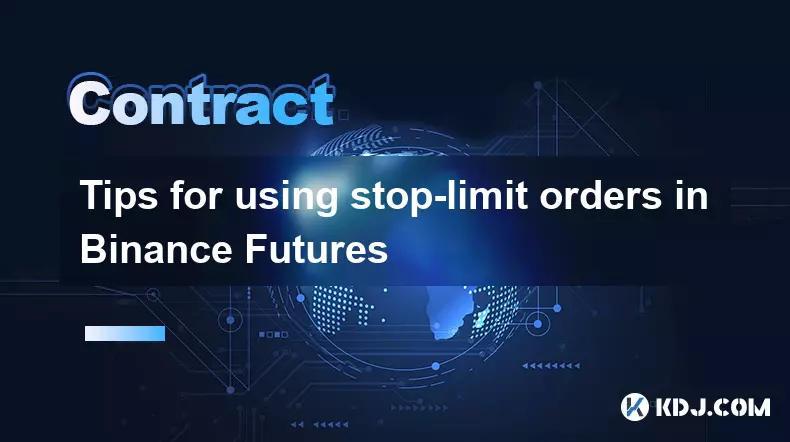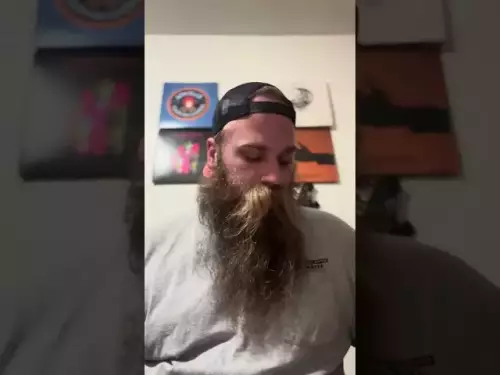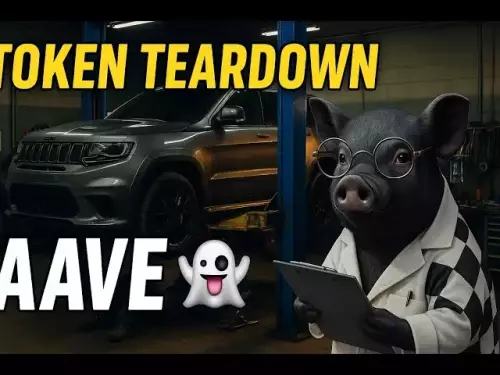-
 bitcoin
bitcoin $112195.049338 USD
2.42% -
 ethereum
ethereum $4124.915858 USD
2.81% -
 tether
tether $1.000570 USD
0.02% -
 xrp
xrp $2.861568 USD
2.25% -
 bnb
bnb $1000.346670 USD
3.04% -
 solana
solana $209.070819 USD
3.38% -
 usd-coin
usd-coin $0.999870 USD
0.02% -
 dogecoin
dogecoin $0.235379 USD
2.65% -
 tron
tron $0.335681 USD
-0.20% -
 cardano
cardano $0.803501 USD
3.38% -
 hyperliquid
hyperliquid $47.120881 USD
3.56% -
 chainlink
chainlink $21.501300 USD
3.44% -
 ethena-usde
ethena-usde $1.000571 USD
0.02% -
 avalanche
avalanche $29.793378 USD
3.62% -
 stellar
stellar $0.366964 USD
2.42%
Tips for using stop-limit orders in Binance Futures
Stop-limit orders on Binance Futures offer precise control over trade entries and exits but require careful placement of stop and limit prices to balance execution likelihood and price protection, especially in volatile or low-liquidity markets.
Sep 17, 2025 at 05:01 pm

Tips for Using Stop-Limit Orders in Binance Futures
Stop-limit orders are powerful tools in Binance Futures trading, allowing traders to manage risk and automate entries or exits under specific market conditions. Understanding how to use them effectively can prevent unnecessary losses and improve execution precision.
Understanding the Components of a Stop-Limit Order
- A stop-limit order consists of two price points: the stop price and the limit price. The stop price triggers the activation of the order, turning it into a limit order once reached.
- After the stop price is hit, the system places a limit order at the specified limit price, which means the trade will only execute at that price or better.
- Unlike market orders, stop-limit orders do not guarantee execution, especially during high volatility when prices gap past the limit level.
- Traders must set both parameters carefully—setting the limit price too close to the stop price increases the chance of non-execution.
- These orders are visible only after the stop price is triggered, so they do not influence the order book until activated.
Strategies for Effective Placement
- Use technical analysis to determine logical stop price levels, such as below support zones for long positions or above resistance for shorts.
- Set the limit price slightly away from the stop price to account for slippage during fast-moving markets, improving the odds of execution.
- Avoid placing stop-limit orders too close to the current market price, as short-term noise can trigger premature activation.
- For aggressive fills, set the limit price farther from the stop price; for more control over entry/exit cost, keep it tighter.
- Consider the average true range (ATR) of the asset to estimate volatility and adjust the distance between stop and limit prices accordingly.
Risks and Limitations to Monitor
- During flash crashes or sudden news events, prices may jump over the limit price immediately after the stop is triggered, leaving the order unfilled.
- In low-liquidity markets, even if the stop is hit, the limit order might not be executed due to insufficient matching orders.
- Over-reliance on stop-limit orders without monitoring open positions can lead to unexpected exposure if orders fail to fill.
- High-frequency trading and algorithmic dominance on Binance can cause micro-price movements that trigger stops before reversing, leading to whipsaws.
- Network latency or exchange congestion may delay order processing, increasing the risk of unfavorable fills or missed executions.
Frequently Asked Questions
What happens if the market price skips over my limit price after the stop is triggered?If the price moves past your limit price without any matching orders at that level, your trade will not execute. This is common during sharp volatility spikes or gaps, where liquidity dries up momentarily.
Can I modify a stop-limit order after placing it?Yes, as long as the stop price has not been reached, you can edit or cancel the stop-limit order through the Binance Futures interface or API.
Is there a difference between a stop-limit and a stop-market order on Binance Futures?Yes. A stop-market order executes as a market order once the stop price is reached, guaranteeing execution but not price. A stop-limit order becomes a limit order upon triggering, offering price control but no execution guarantee.
Should I use stop-limit orders for both taking profits and cutting losses?While possible, stop-limit orders are generally better suited for profit-taking where timing is less urgent. For loss protection, many traders prefer stop-market orders to ensure exit even at worse prices during crashes.
Disclaimer:info@kdj.com
The information provided is not trading advice. kdj.com does not assume any responsibility for any investments made based on the information provided in this article. Cryptocurrencies are highly volatile and it is highly recommended that you invest with caution after thorough research!
If you believe that the content used on this website infringes your copyright, please contact us immediately (info@kdj.com) and we will delete it promptly.
- Creator Economy Revolution: Video Streaming, AI Algorithms, and the Tokenization Tsunami
- 2025-09-29 10:25:16
- Kaito Launchpad Soars: $170 Million Pledged, Price Targets $1.50 – Is the AI Hype Real?
- 2025-09-29 11:45:16
- Bitcoin, Ethereum, and Q4 Predictions: What's the Buzz?
- 2025-09-29 10:25:16
- Token Unlocks, DeFi, and Tokenomics: Navigating the Crypto Landscape
- 2025-09-29 10:45:13
- Crypto Bull Wipeout? Dollar Strength Steals the Show!
- 2025-09-29 10:30:01
- AlphaTON, TON, and Meme Tokens: What's the Haps?
- 2025-09-29 10:45:13
Related knowledge

How do I use the scheduled order feature in Cardano (ADA) contracts?
Sep 28,2025 at 10:18pm
Understanding Scheduled Orders in Cardano Smart ContractsCardano operates on a proof-of-stakes consensus mechanism and uses the Plutus scripting langu...

How do I enable the "scalping-only" mode for Cardano (ADA) contracts?
Sep 24,2025 at 03:19am
Understanding Scalping Strategies in Crypto Derivatives1. Scalping in cryptocurrency trading refers to executing multiple short-term trades within min...

What is the settlement time for Cardano (ADA) contracts?
Sep 28,2025 at 04:18am
Understanding Cardano's Contract Settlement Mechanism1. Cardano operates on a proof-of-stake consensus model known as Ouroboros, which fundamentally i...

How do I add margin to Cardano (ADA) contracts?
Sep 27,2025 at 07:54pm
Understanding Margin in Cardano (ADA) Smart ContractsCardano operates on a proof-of-stake blockchain that supports smart contracts through its Plutus ...

What is the maximum position limit for Cardano (ADA) contracts?
Sep 23,2025 at 11:00pm
Understanding ADA Futures and Derivatives Market Structure1. Cardano (ADA) futures contracts are offered by several major cryptocurrency derivatives e...

What is the maker fee for Cardano (ADA) contracts?
Sep 26,2025 at 09:01am
Understanding Maker Fees in Cardano (ADA) Contracts1. The concept of maker fees applies broadly across decentralized exchanges and smart contract plat...

How do I use the scheduled order feature in Cardano (ADA) contracts?
Sep 28,2025 at 10:18pm
Understanding Scheduled Orders in Cardano Smart ContractsCardano operates on a proof-of-stakes consensus mechanism and uses the Plutus scripting langu...

How do I enable the "scalping-only" mode for Cardano (ADA) contracts?
Sep 24,2025 at 03:19am
Understanding Scalping Strategies in Crypto Derivatives1. Scalping in cryptocurrency trading refers to executing multiple short-term trades within min...

What is the settlement time for Cardano (ADA) contracts?
Sep 28,2025 at 04:18am
Understanding Cardano's Contract Settlement Mechanism1. Cardano operates on a proof-of-stake consensus model known as Ouroboros, which fundamentally i...

How do I add margin to Cardano (ADA) contracts?
Sep 27,2025 at 07:54pm
Understanding Margin in Cardano (ADA) Smart ContractsCardano operates on a proof-of-stake blockchain that supports smart contracts through its Plutus ...

What is the maximum position limit for Cardano (ADA) contracts?
Sep 23,2025 at 11:00pm
Understanding ADA Futures and Derivatives Market Structure1. Cardano (ADA) futures contracts are offered by several major cryptocurrency derivatives e...

What is the maker fee for Cardano (ADA) contracts?
Sep 26,2025 at 09:01am
Understanding Maker Fees in Cardano (ADA) Contracts1. The concept of maker fees applies broadly across decentralized exchanges and smart contract plat...
See all articles










































































